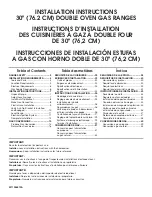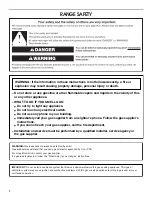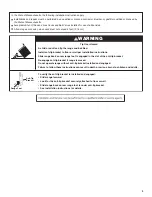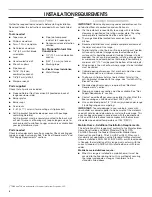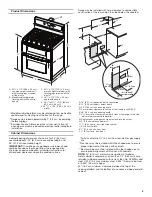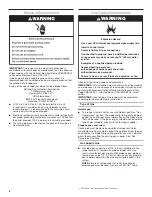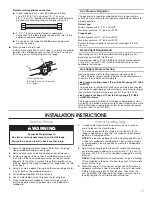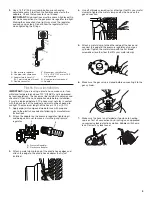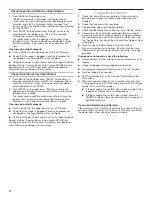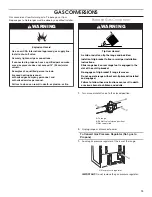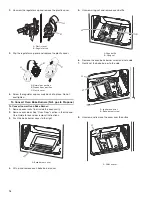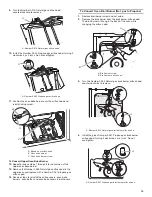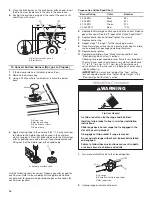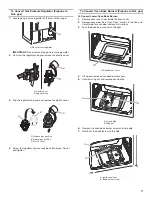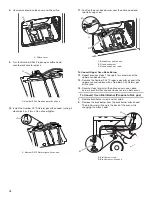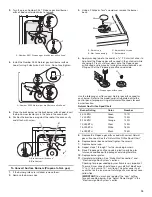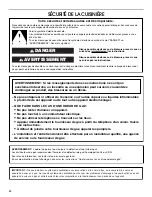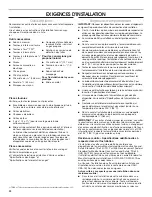
7
Flexible metal appliance connector:
■
If local codes permit, a new CSA design-certified,
4 to 5 ft (122 to 152.4 cm) long, 1/2" (1.3 cm) or
3/4" (1.9 cm) I.D., flexible metal appliance connector may
be used for connecting range to the gas supply line.
■
A 1/2" (1.3 cm) male pipe thread is needed for
connection to the female pipe threads of the inlet to the
appliance pressure regulator.
■
Do not kink or damage the flexible metal tubing when
moving the range.
■
Must include a shutoff valve:
Install a manual gas line shut-off valve in an easily accessible
location. Do not block access to shut-off valve. The valve is
for turning on or shutting off gas to the range.
Gas Pressure Regulator
The gas pressure regulator supplied with this range must be
used. The inlet pressure to the regulator should be as follows for
proper operation:
Natural gas:
Minimum pressure: 5" (12.7 cm) WCP
Maximum pressure: 14" (35.6 cm) WCP
Propane gas:
Minimum pressure: 11" (27.9 cm) WCP
Maximum pressure: 14" (35.6 cm) WCP
Contact local gas supplier if you are not sure about the inlet
pressure.
Burner Input Requirements
Input ratings shown on the model/serial rating plate are for
elevations up to 2,000 ft (609.6 m).
For elevations above 2,000 ft (609.6 m), ratings are reduced at
a rate of 4% for each 1,000 ft (304.8 m) above sea level (not
applicable for Canada).
Gas Supply Pressure Testing
Gas supply pressure for testing regulator must be at least
1" (2.5 cm) water column pressure above the manifold pressure
shown on the model/serial rating plate.
Line pressure testing above 1/2 psi (3.5 kPa) gauge [14" (35.6
cm) WCP]
The range and its individual shutoff valve must be disconnected
from the gas supply piping system during any pressure testing of
that system at test pressures in excess of 1/2 psi (3.5 kPa).
Line pressure testing at 1/2 psi (3.5 kPa) gauge [14" (35.6
cm) WCP] or lower
The range must be isolated from the gas supply piping system
by closing its individual manual shutoff valve during any pressure
testing of the gas supply piping system at test pressures equal
to or less than 1/2 psi (3.5 kPa).
INSTALLATION INSTRUCTIONS
Unpack Range
1.
Remove shipping materials, tape and film from the range.
Keep cardboard bottom under range.
2.
Remove oven racks and parts package from inside oven.
3.
To place range on its back, take 4 cardboard corners from
the carton. Stack one cardboard corner on top of another.
Repeat with the other 2 corners. Place them lengthwise on
the floor behind the range to support the range when it is laid
on its back.
4.
Using 2 or more people, firmly grasp the range and gently lay
it on its back on the cardboard corners.
5.
Pull cardboard bottom firmly to remove.
6.
Use an adjustable wrench to loosen the leveling legs.
7.
Place cardboard or hardboard in front of range. Using 2
or more people, stand range back up onto cardboard or
hardboard.
Adjust Leveling Legs
1.
If range height adjustment is necessary, use a wrench or
pliers to loosen the 4 leveling legs.
This may be done with the range on its back or with the
range supported on 2 legs after the range has been placed
back to a standing position.
NOTE:
To place range back up into a standing position, put
a sheet of cardboard or hardboard in front of range. Using 2
or more people, stand range back up onto the cardboard or
hardboard.
2.
Adjust the leveling legs to the correct height. Leveling legs
can be loosened to add up to a maximum of 1" (2.5 cm). A
minimum of 3/16" (5.0 mm) is needed to engage the anti-tip
bracket.
NOTE:
If height adjustment is made when range is standing,
tilt the range back to adjust the front legs, then tilt forward to
adjust the rear legs.
3.
When the range is at the correct height, check that there is
adequate clearance under the range for the anti-tip bracket.
Before sliding range into its final location, check that the
anti-tip bracket will slide under the range and onto the rear
leveling leg prior to anti-tip bracket installation.
A
B
C
A. Gas supply line
B. Shutoff valve “open” position
C. To range
WARNING
Excessive Weight Hazard
Use two or more people to move and install range.
Failure to do so can result in back or other injury.

